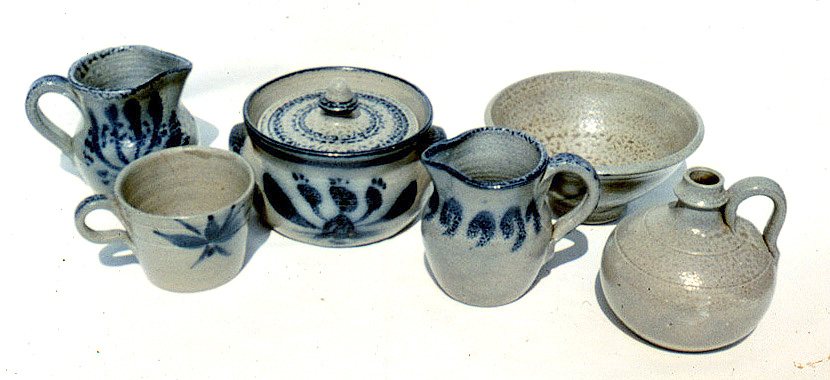Harvey Littleton wanted to learn about salt glazing so he contacted
Mrs. Busbee at Jugtown and she invited Harvey and me to come and
observe a firing to see how their process went.
In about the summer of 1954 [actually 1957 --
see above] Harvey and I drove to Jugtown with
a tent and equipment. Somehow I arrived without anything, so Mrs.
Busbee, who owned the pottery, let me stay in the house.
They had a horse-drawn pug mill run by Mr. Whitaker. Ben Owens
was the master potter. Harvey and I threw a number of pieces --
some in stoneware for salt glazing and some in a red clay for
what they called their red ware. They dug up the stoneware clay
nearby and some big terra cotta company had purchased this clay
deposit and the Jugtown potters were having a hard time getting
good clay to use. They put it through the pug mill just as it
came which made it moist and plastic. Each person would take
about a ten pound lump of clay and slice it with a wire fairly
thin; then examine each slice and pick out the pebbles. At that
time Mrs. Busbee was proud of the fact that they were using
colonial methods. The picked clay was probably worth its weight
in gold. It was kept in a pit in the potting shed covered with
wet burlap. Everybody knew where his lump was and not to bother
anybody else's lump. The only concession to the twentieth century
was a single electric light bulb hanging from the ceiling. We
threw on treadle wheels. They had very heavy wareboards about 2
by 8 and 8 or 10 feet long.
The pieces were then dried and fired in ground hog kilns --
one for salt glaze and one for low temperature redware. The only
access to inside the kiln was climbing through the fire mouth. A
person would stand outside the kiln, one in the firebox and one
inside. The pots were handed from person to person and the one
inside would place it in the kiln.
[See
photo of Ben Owen Sr. doing this.]
There were no shelves. The
pots just sat on flintstone gravel, fractured and sharp so it
served as a kind of stilt. There was one level of of pots from firebox
to chimney. Kilns were about fifteen feet long and about six or seven feet
wide. The chimney was the full width of the kiln and not very tall.
Kilns were set into the hill. Then the ground rose up even with the top of the
kiln. We could walk around and look in the chimney.
The kilns were wood fired. Red ware was glazed with high red lead glaze
which tended to settle out all the time so you had to stir it. Fired
to approximately cone 05 or 05. The salt glaze was cone 11. The kiln
was started in the morning and went late into the night. The fire mouth was about two feet squeare and never bricked up.
A sheet iron hung over the front of the box, was swung over to the side to stoke
the kiln. Then swung to cover the box again. Salt was dropped throught several
holes in the roof in the arch of the kiln. The holes were covered
with bricks. We shoved them to one side and poured a dipper full of rock
salt in. Some pieces under holes came out of the kiln half full
of melted salt and had to be soaked to get the salt out.
Altogether we spent about ten days throwing and firing. Mrs. Busbee
cooked for us. She was very welcoming and hospitable.
We offered to pay her when we got ready to come home, but she said
just our being there was pay enough.
They had a source of moonshine whiskey and they gave each of us enough
to fill a little whiskey jug we had made, salt glazed. Although the
jugs were fired to cone 11, the whiskey slowly evaporated away. In all my
pieces I tried to copy their historic designs which went back to the
Civil War, or perhaps earlier. Potters were exempt from service
because their wares were needed in hospitals and camps.
The Busbees had gone around the region acquiring pieces made before
the Civil War so they could make authentic soap dishes, plates,
bowls, mugs, etc. The mugs made for the Civil War were called
Confederate mugs.
We had a delightful ten days and learned a lot.
